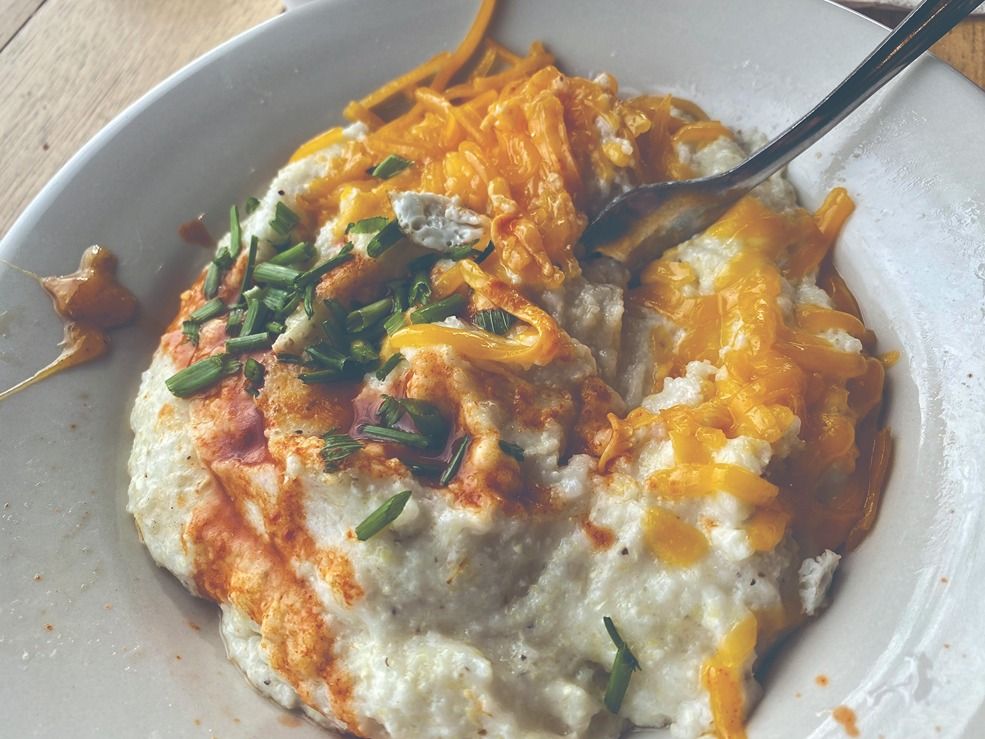New Orleanians have a longstanding relationship with grits. Most of us grew up eating them at every meal. We have family recipes. We live by the cardinal rules of grits: Never cook them in water. And slapping a piece of American cheese on top of a pile of grits doesn't really make it cheese grits. Good grits are made with milk, cream, butter, and often cheese—mixed in and not just surfing on top, all rubbery and congealed.
Not surprisingly, the rest of the world has finally caught on to what we've known all along: Grits are easy, versatile, and, if prepared like we know how, extremely delicious. That's why they have now moved beyond the breakfast plate and beyond the South. While still a breakfast staple, they can also be a side dish, bar snack, or dinner entrée. Comfort food or haute cuisine, grits have gone global and exist in many forms: cheese grits, shrimp and grits, grits and grillades, grit cakes. But how did they come so far? What are the origins of this corny classic? And who in New Orleans serves the best?
Read on as we get into the nitty gritty of grits.

True grits
Grits are made from either stone-ground corn or hominy, which is really just another form of corn. Corn becomes hominy after it's soaked in an alkaline solution, such as lime or lye, to soften the hull for easy removal. The corn used to make most grits is known as dent, which refers to several not-so-sweet, less-starchy types of corn.
There are both white grits and yellow grits, based on which type of corn they came from. But that method of identification isn't foolproof—it's hard to differentiate between yellow grits and white grits that are simply swimming in butter.
Maize I Have Some More, Please?
Evidence suggests that the people of Central America were already milling corn as early as 8700 B.C., which means that they likely ate some sort of precursor of our grits. However, grits as we know and love them today originated in the Southeastern U.S. and have been traced back at least as far as the 16th century, among the Muscogee tribe of Native Americans. The Natives were known to eat a porridge of mushy corn, or maize, which they shared with the Europeans when they invaded their lands.
Arthur Barlowe, an explorer on Sir Walter Raleigh's expedition in what later became North Carolina, allegedly wrote accounts of having eaten meals of a "very white, faire, and well-tasted" corn dish known as rockahomine. This dish, which was also served to the colonists at Jamestown when they arrived there in 1607, quickly caught on among the settlers, who began calling it just "hominy" for short.
Children of the Corn
Geography, botany, and Southern resourcefulness and grit helped promote the popularity of grits throughout the South. Corn is a native North American crop that thrives in warmer climates, and early Southerners learned to take full advantage of the entire plant. Grits aren't the only edible product to come out of the cornstalk. From cornbread to moonshine to hush puppies, there's an endless list of corn-based Southern specialties.
Soon, nearly everyone in the South was eating grits, but especially the ordinary masses. Poor farmers ate them. Enslaved people on plantations ate and served them. The enslaved also passed down their grit-eating tendencies to their children, and their children's children. Their descendants, the Gullah Geechee people of South Carolina, are said to have invented shrimp and grits.
Farm to Table
What was once primarily the food of commoners in the rural South now graces the tables of fancy eateries and fine-dining establishments across the country, though it's still a Southern staple. In fact, 75 percent of all the grits sold in the U.S. are purchased by Southerners. The South consumes so many grits that the stretch of country from southern Virginia down to south Texas has become known as the "Grits Belt," and the states it encompasses are home to the grittiest folks in America.
Grits have even been designated the official prepared food of Georgia. Chapter 29 of the South Carolina code of laws is devoted entirely to rules that regulate grits and cornmeal. And in Louisiana, we eat them with everything from chicken to chorizo to Cheetos.
Below the Belt
Never mind the Mason-Dixon Line, there's another boundary that really divides the North from the South: The upper boundary of the Grits Belt is sometimes referred to as the "Grits Line." People living south of that line are regular grits corn-isseurs—the type who view instant grits with corn-tempt, as an absolute corn-tastrophe. Those above the line would probably rather just eat oatmeal.

